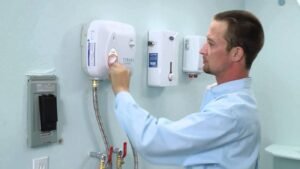In bustling Dubai, a functioning water heater is crucial for daily comfort and efficiency. Whether for showers, dishes, or household tasks, hot water is a necessity. Timely repair and maintenance of heaters are essential to prevent disruptions. This article outlines seven critical steps for Water Heater Repair In Dubai, ensuring safety, efficiency, and longevity of your appliance.
Initial Inspection
A. Assessing the Issue with the Water Heater
The first step in any water heater repair is to conduct a thorough initial inspection. A professional starts by examining the external condition of the heater, confirming the type (tankless, storage, gas, electric), and observing any visible signs of wear or damage.
B. Identifying Potential Causes of Malfunction
After a preliminary review, the expert plumber attempts to pinpoint the potential causes of malfunction. These can range from sediment build-up, faulty heating elements, or deteriorated anode rods to more severe issues such as leaks or a compromised tank integrity.
Shutting Off Utilities
A. Turning Off Water Supply
Before proceeding with direct interaction with the water heater, it’s essential to shut off the water supply to prevent any possible water damage or safety hazards. Ensuring this step is handled correctly avoids the risks associated with water spilling or pressure build-up.
B. Disconnecting Electricity or Gas Supply
Additionally, disconnecting the heater from its power source – whether electricity or gas – is a critical safety measure, helping to prevent accidents due to electric shock or gas leaks during the repair process.
Troubleshooting and Diagnosis
A. Testing Heating Elements and Thermostat
A water heater usually encounters issues in its heating components. A technical diagnosis involves testing the resistance of the heating elements with a multimeter and assessing the functionality of the thermostat. This step determines whether these parts require cleaning, repair, or replacement.
B. Checking for Leaks or Corrosion
Leaks and corrosion can be the silent killers of water heater efficiency. Inspecting connections, pipes, and the tank itself for any signs of leaking water, rust, or corrosion is essential for a comprehensive troubleshooting process.
Repairing or Replacing Components
A. Replacing Faulty Heating Elements or Thermostat
In cases where these parts are found to be defective, a professional implements the appropriate remedies. This may involve uninstalling the faulty elements, selecting the right replacements, and expertly installing the new components.
B. Repairing or Sealing Leaks
If leaks are identified, they should be promptly sealed or repaired. This could encompass tightening connections or applying sealants, as well as possibly replacing portions of piping or damaged components.
C. Cleaning or Flushing Sediment from the Tank
One common issue that affects water heaters, particularly in areas with hard water, is the accumulation of sediment. This step involves cleaning the tank and flushing out any sediment, which can improve both efficiency and the lifespan of the heater.
Testing and Reassembly
A. Refilling the Tank with Water
Once repairs or replacements are complete, the tank is refilled cautiously, observing for any signs of leakage or malfunction during the process.
B. Reconnecting Plumbing and Wiring
After the tank is filled, all plumbing and wiring are reconnected methodically, ensuring that every element is correctly installed and secured.
C. Testing for Proper Functionality
The final step in the repair process is to test the water heater’s functionality. The water heater is turned on and closely monitored for temperature consistency and operation without hitches to confirm a successful repair.
Clean-up and Completion
A. Tidying Up the Work Area
Post-repair, maintaining a neat work environment is important. The technician cleans up, ensuring that no tools or debris are left behind.
B. Providing Client Instructions for Maintenance
To minimize future issues, professionals often provide clients with essential maintenance tips and schedules to keep the water heater in optimal condition.
C. Documenting the Repair Process
For warranty and service tracking purposes, it’s standard to document the repair, noting what was fixed, replaced, or maintained. This record can be valuable for both the repair service and the client.
Conclusion
The process for repairing a water heater in Dubai is meticulous and involves an initial inspection, shutting off utilities, troubleshooting and diagnosis, repairing or replacing components, testing and reassembly, clean-up, and completion. For residents of Dubai, facing a broken water heater can be daunting. Seeking professional assistance from HMSD Handyman Services Dubai ensures a thorough and safe repair, upholding the practices outlined in these seven essential steps. With expert help, residents can enjoy peace of mind with reliable hot water access in their daily lives.
Frequently Asked Questions (FAQs)
1. How often should I have my water heater inspected in Dubai to prevent major repairs?
Answer: It’s generally recommended to have your water heater inspected at least once a year. Regular inspections can help identify and address small issues before they escalate into major repairs. In areas with hard water, such as certain parts of Dubai, more frequent checks might be necessary to manage sediment buildup effectively.
2. Can I perform any water heater maintenance tasks myself to extend its lifespan?
Answer: Yes, there are several maintenance tasks you can perform to help extend the lifespan of your water heater. These include periodically draining the tank to remove sediment, testing the pressure relief valve to ensure it’s functioning correctly, and checking the anode rod for corrosion (and replacing it if necessary). However, if you’re unfamiliar with these processes, consulting a professional is advisable to avoid accidental damage.
3. What are the signs that indicate my water heater might need repair or replacement?
Answer: Several signs could indicate your water heater might need repair or replacement. Common warning signs include inconsistent water temperature, discolored water, unusual noises coming from the tank, leaks around the base of the heater, and a significant decrease in the efficiency of water heating. If you notice any of these signs, it’s best to contact a professional to assess your water heater’s condition.
